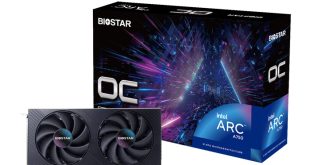The new 6800 series has seen hardware architecture changes, with a focus on strengthening tessellation and geometry throughput. Avid readers of KitGuru will have seen over recent months that nVidia Fermi hardware has been leading the way in titles such as UniGine Heaven Benchmark, a synthetic test which relies heavily on Tessellation performance.
The 6800 series has a reconfigured core design which offers up to 2.0 TeraFLOPS and 24 Gigapixels per second performance. The command processor is linked to the graphics engine as seen in the diagram above, with the new generation 7 Tessellator. The Dual rasterizers and 12-14 SIMD engines tied to a 256 bit GDDR5 memory interface help to improve performance beyond the levels of the last generation, while using 25% less silicon.
|
AMD HD5850
|
AMD HD6870
|
|
| Die Size |
334 mm2
|
255mm2
|
| Transistors |
2.15 billion
|
1.7 billion
|
| Memory Bandwidth |
153.6GB/sec
|
134.4 GB/sec
|
| Geometry Throughput |
725 million polygons/sec
|
900 million polygons/sec
|
| SIMD Engines |
18
|
14
|
| Stream Processors |
1440
|
1120
|
| Texture Units |
72
|
56
|
| Z/Stencil ROPs |
128
|
128
|
| Colour ROPs |
32
|
32
|
| Max Board Power |
151W
|
151W
|
| Idle Power |
27W
|
19W
|
The table above shows a direct comparison against the HD5850 and HD6870. The HD6870 has less texture units, SIMD engines, Stream Processors with a lower memory bandwidth but the Geometry throughput has been significantly increases from 725 million polygons per second to 900 million polygons per second. The new design is more efficient and with the die shrink requires less power at idle.
|
Hardware Tessellator Progression
|
||
| Generation 1 |
ATI Radeon 8500
|
Fixed Function PN Triangles (TRUFORM)
|
| Generation 2 |
Microsoft Xbox 360
|
Displacement mapping, adaptive tessellation
|
| Generation 3 |
AMD Radeon HD2000 family
|
Dirext X 10 compatibility
|
| Generation 4 |
AMD Radeon HD 3000 family
|
Direct X 10.1 compatibility
|
| Generation 5 |
AMD Radeon HD 4000 family
|
Performance Enhancements
|
| Generation 6 |
AMD Radeon HD 5000 family
|
Direct X 11 compatibility
|
| Generation 7 |
AMD Radeon HD 6800 Series
|
Improved Thread Management and buffering
|
The updated Tessellation unit, called ‘Generation 7' brings new thread management capabilities as well as buffering enhancements to the table. This means that performance is increased by up to two times when directly compared to the HD5000 series. This should mean that AMD are closely competitive with similarly priced nVidia Fermi hardware, we will look at performance later in this article. AMD's internal testing shows that the HD6870 achieves twice the tessellation performance of the HD5870.
Tessellation is a hotly discussed topic right now, and it is a bone of contention between nVidia and AMD. Our recent interview with Richard Huddy opened a few eyes, as he said “nVidia is pushing a single message and that’s tessellation. Tessellation is about enriching detail, and that’s a good thing, but nVidia is pushing to get as much tessellation as possible into everything. With artificial tests like Stone Giant, which was paid for by nVidia, tessellation can be done down to the single pixel level. Even though that pixel can’t be broken away from the 3 other pixels in its quad. Doing additional processing for each pixel in a group of 4 and then throwing 75% of that work away is just sad.”
AMD's stance on this is “Tessellating the Right Way” – which means a focus on the most efficient tessellation usage models with 16 pixels per polygon combining solid image quality with high levels of performance. Adaptive Tessellation is how they want to approach it, using high levels for objects close to the front of the screen (and in eye shot of the gamers) and then switch to lower levels for distant and simple objects to help improve performance while avoiding geometry aliasing problems.
The image above was captured from Alien V Predator and showcases the new Morphological Anti-Aliasing technique from AMD which is a post process filtering technique accelerated with DirectCompute. It delivers full scene anti Aliasing and it is not limited to polygon edges or alpha tested surfaces. The system is faster than super sampling with similar performance levels to edge detect CFAA, but it applies to all edges. This can be enabled from Catalyst Control Center and is compatible with any Direct X 9/10/11 supported application.
Anistrophic Filtering has also been fine tuned and enhanced with a newly refined algorithm in place. It addresses visible discontinuities in very noisy textures offering smoother transitions between filter levels. It also maintains full performance and angle independence.
 KitGuru KitGuru.net – Tech News | Hardware News | Hardware Reviews | IOS | Mobile | Gaming | Graphics Cards
KitGuru KitGuru.net – Tech News | Hardware News | Hardware Reviews | IOS | Mobile | Gaming | Graphics Cards







